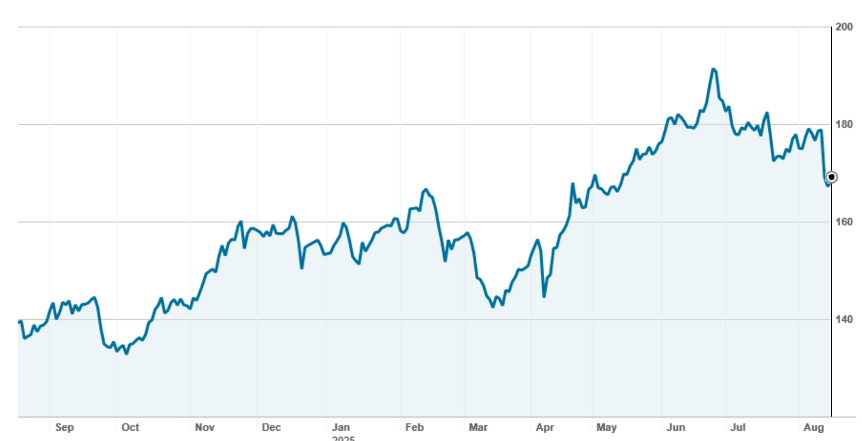Although the sharemarket is at record highs, the biggest company on the ASX, CBA, is off 12% from its peak. Last week, it delivered an “as expected” full year result, but the stock fell by around 4%. Have the wheels started to fall off?
Last Friday, the Australian sharemarket closed at a record high of 8,938. The biggest company Commonwealth Bank (CBA), with a market weighting of 10.43%, closed at $168.17, 12.1% lower than its record closing high of $191.40 on 25 June. This came after an “as expected” full year profit result that saw the stock lose 4.8% over the week.
Have the wheels started to fall off on what arguably must be one of the most over-priced stocks in Australian sharemarket history?
Let’s take a closer look at the result and how the other banks are reporting, and what the major brokers have to say.
CBA’s results
Cash NPAT for the full year of $10,252m was up 4% on FY24. The second half profit of $5,120m, due in part to fewer days, was flat on the first half.
Operating income was up 4.8%, with small volume growth and a stable net interest margin, while operating expenses increased by 6.1%. Operating performance (before loan impairment expenses) improved by 3.4%. Loan impairment expenses reduced from $802m in FY24 to just $726m in FY25, although the second half ticked up on the first half. Historically, at 7 bps of the overall lending book, they remain well below the long term average.
Highlights included:
- Business banking gains, with business lending balances growing at 1.3 times system growth and customer share (main financial institution) growing from 25.5% at June 24 to 27.3% at June 25;
- Home loans growing at system, with 66% being sourced through proprietary channels (rather than the more expensive broker channel);
- The stabilisation in the net interest margin, up 2bps on an underlying basis, with hedging and treasury earnings offsetting competition effects. Interestingly, Westpac reported a 5bp improvement in its quarterly report, while NAB improved by 4bp;
- Continuing improvements in customer service, with the NPS (net promoter score) for consumers and businesses growing, and CBA “number1“ amongst the major banks for consumer, business and digital channels;
- CBA providing its customers with “global best digital experiences”;
- Progress on AI, with more than 2,000 AI models in use across the Bank and partnerships with Anthropic and OpenAI;
- Very strong position on capital and peer leading provision coverage. CBA’s CET1 capital ratio stood at 12.3%, well above CBA’s internal target of 11.0% and APRA’s regulatory minimum of 10.25%; and
- Final dividend of $2.60 per share, up from $2.50 in FY24. Full year of $4.85, up 4% on the $4.65 in FY24.
On the negative side, CBA’s cost to income ratio deteriorated from an average of 45.0% in FY24 to 45.7% in FY25, with the second half even higher at 46.1%. The Bank’s NZ division (ASB Bank) delivered an underwhelming result.
What do the brokers say about CBA?
The major brokers remain bearish on CBA, feeling that it is too expensive relative to its major bank competitors and banks internationally. According to FN Arena, all major brokers have a ‘sell’ recommendation (see table below).

The consensus target price is $112.81, a whopping 33% lower than Friday’s ASX close of $168.17.On multiples, the brokers have CBA trading at 26.6 times forecast FY26 earnings and 25.3 times forecast FY27 earnings, and paying a prospective yield of just 3.0%.
Jarden, who is not part of the major broker pool that FN Arena accesses, cut their price target from $110.000 to $100.00 and had this to say about the result:
“CommBank’s FY25 result was slightly below Jarden’s expectations and of lower quality, with around 59% of revenue growth driven by trading gains and derivative valuation adjustments.
The broker highlights a stable net interest margin (NIM) at 2.08% and 3.9% growth in both loans and deposits, though asset quality softened slightly with impaired loans up to 0.97% and provisions down to 1.39%.
Capital remains strong at 12.3%, in the analysts’ opinion, supporting the $2.60 per share final dividend, but buybacks are off the table due to dilution.
Jarden observes Retail and New Zealand weakness offset business and institutional gains, and sees the bank’s valuation as vulnerable to mean reversion. The broker cautions lower rates will erode CBA’s deposit funding advantage while competition intensifies.”
CBA’s last 12 months:

Source: nabtrade
Commonwealth Bank’s recent price weakness has been triggered by two factors. Firstly, sector rotation away from banks into resources as the outlook for commodities steadies. Secondly, peer rotation – a realisation that not only is CBA horrendously expensive compared to the market, but it is horrendously expensive compared to its peers.
CBA has always traded at a premium to its peers, but with a new broom of CEOs in place at the other majors, the institutions are liking what they are hearing and the results they are starting to see. The gap on multiples (CBA 26.6x, ANZ 14.5x, NAB 17.7x and Westpac 18.4x) is too big.
The bull case for CBA is that it keeps on doing what it has been doing and that CEO Matt Comyn can aggressively leverage its leadership in technology and AI to improve customer service and reduce costs.
But this will require considerable investment in the short term and his competitors won’t just watch and stand by. Mean reversion looks like the most likely scenario.
Underweight the sector (banking) and underweight CBA.

